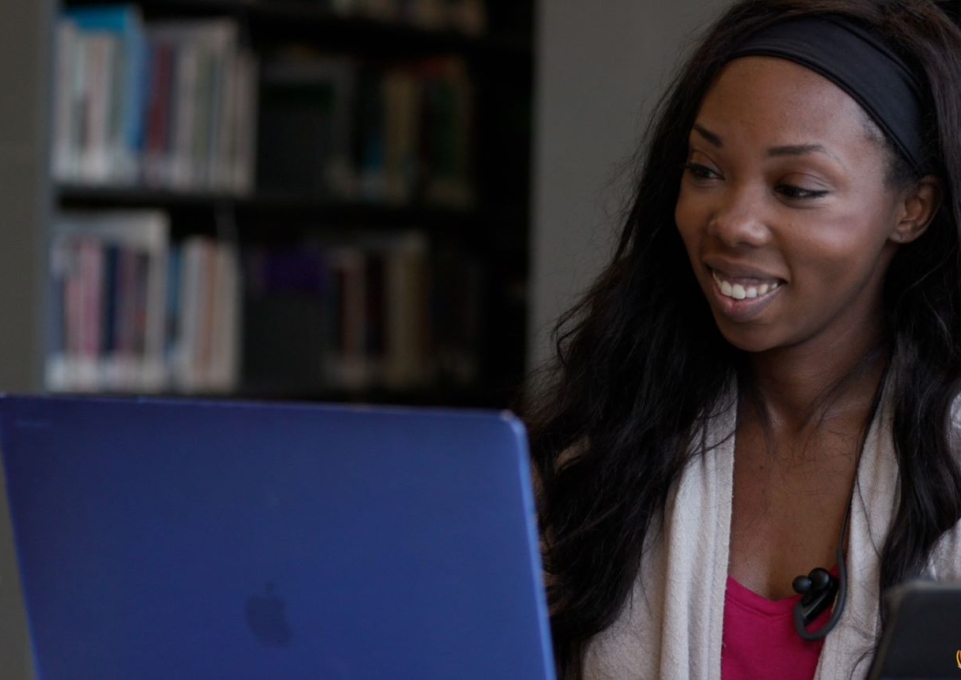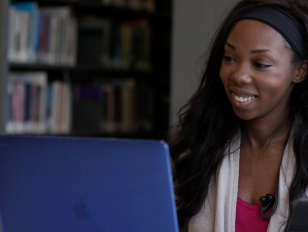
When Tanisha Robinson first took Organic Chemistry II as a transfer student at Buffalo State College, she felt overwhelmed and ended up dropping the course.
“I had way too much going on,” she said. “I was working 30 to 50 hours per week as a pharmacy technician at Buffalo General Hospital and commuting a long distance. I wasn’t focused and wasn’t keeping up.”
Sujit Suwal, the assistant professor of chemistry who taught the course, seemed disheartened, she said, but understood.
“When I re-enrolled in the class the following semester, he was ecstatic,” said Robinson, who earned a degree in biology in 2020. “He challenged me, and I was prepared for the challenge.
“Even though I was taking 17 credit hours, working, and raising my daughter, I was determined to get a good grade. It was worth it.”
Robinson not only excelled, but she also said it was her favorite undergraduate class. It also contributed to her decisions to add a chemistry minor to her degree plan and to pursue a master’s degree in science education. She’s wrapping up her coursework at Buffalo State this summer and expects to earn her master’s degree in August.
“Tanisha is a very independent and detail-oriented student,” Suwal said. “She has an audacity for asking the question until she finds the satisfying answer.”
This propensity for finding answers led Robinson toward science, beginning in high school.
“My family was more into literature and music,” explained Robinson, who grew up in North Buffalo and graduated from Bennett High School. “I was a rebel. I wanted something more hands-on and focused on the ‘why’ and ‘how’ of life. You can push scientific arguments a little further, and I like that science is a universal language; it’s cross-cultural.”
Robinson said she was inspired by her professors, particularly Martha Skerrett, professor of biology, who taught Robinson’s first biology course at Buffalo State.
“I liked how organized she was and how confident she was in the material,” Robinson said. “When I found out she was involved in undergraduate and graduate research, I figured she would play a pivotal role in my growth at Buffalo State. And she has.”
Skerrett believed in Robinson to the point that she invited her to serve as a teaching assistant in her Foundations of Biology course just one year after Robinson completed it.
“That’s where I first gained experience in teaching,” she said. “I grew a lot, and she gave me feedback. Working with Dr. Skerrett helped me develop strategies and reassured me that teaching was for me.”
“My goal is to find ways to take challenging, complex content that people usually run away from and make it tangible and visual. Science is very abstract. I try to use analogies and metaphors so people can discover it’s not that hard; it’s just unfamiliar.”
Serving as a student teacher in the public schools also reinforced Robinson’s belief in a career as a science teacher.
“I honestly thought I would dislike teaching middle schoolers. I didn’t want any part of classroom behavior management,” she said. “But that experience was more rewarding than I thought it would be. The kids are hilarious. They’re unpredictable, and every day is fun.”
In the spring, she completed her second school placement in Clarence, New York. She taught in a synchronous mix of virtual and in-person science classes.
“If I had a day that was challenging or if I felt like I was moving clumsily, the students didn’t care,” she said. “They roll with the punches right along with you. They’re resilient. They’ve done such a great job of having to be independent students at home and swapping out the virtual setting with in-person instruction. I commended them for their strength.”
She also challenged them, especially the girls, who surprised Robinson by not engaging with the material or working as hard as their male counterparts.
“I’d tell them: ‘You can dominate science, too,’” she said. “‘If the boys win today, they win today. I’m going to challenge you girls tomorrow. I’m not going to let you off the hook.’”
Robinson said she’s learned from both this experience and a previous placement in Depew, New York, that to be an effective teacher, you have to get creative. For one science writing assignment, she used concepts from a Super Bowl commercial to inspire the students.
“They had so much fun. I had 100 percent engagement, and they actually learned the content,” she said. “That was very rewarding.”
Along with conveying science concepts to students, Robinson wants to connect with larger audiences through a YouTube channel she recently created. She said she plans to present lessons on everything from health and fitness to chemistry and biology. In one, she explains how hand sanitizers work to kill germs, incorporating several fun graphics.
“My goal is to find ways to take challenging, complex content that people usually run away from and make it tangible and visual,” she said. “Science is very abstract. I try to use analogies and metaphors so people can discover it’s not that hard; it’s just unfamiliar. That’s my strong point with teaching.”
Video by John Myers and Ken Giangreco, Buffalo State College Creative Services.



